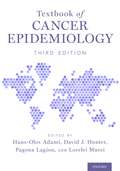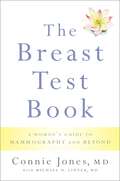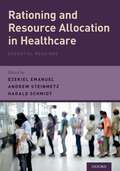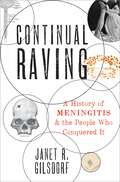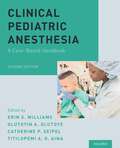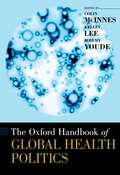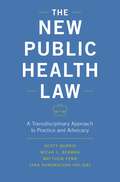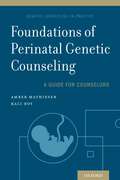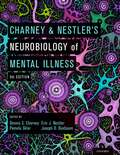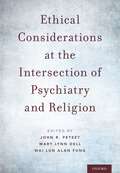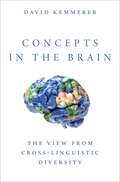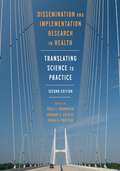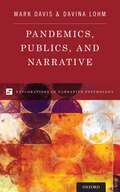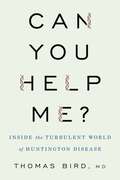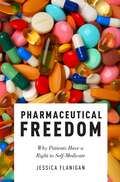- Table View
- List View
Textbook of Cancer Epidemiology
by Hans-Olov Adami, David J. Hunter, Pagona Lagiou, Lorelei Mucci and Brian Macmahon"Comprehensive and comprehensible, but also encouraging -- informed by the hope and belief that informed its creation." -Cancer Amid sweeping advances in the science and treatment of cancer, the TEXTBOOK OF CANCER EPIDEMIOLOGY offers students and professionals a definitive, systematic resource for understanding the factors affecting all types of human cancer. This fully updated new edition offers an overview of epidemiology's key concepts and methods as they relate to cancer (including the emerging potential of biomarkers) as well as site-specific chapters on individual cancers' natural history, pathology, descriptive epidemiology, and etiology. Taken together, these chapters forge connections between established science and the ongoing evolution of this dynamic field. Crisply and concisely written by an assembly of internationally recognized researchers, the TEXTBOOK OF CANCER EPIDEMIOLOGY offers a superlative introduction to the subject's consensuses and controversies for those embarking on their careers and a ready reference for seasoned professionals.
The Breast Test Book: A Woman's Guide to Mammography and Beyond
by Connie JonesBreast cancer is the most commonly diagnosed malignancy in women and the second leading cause of cancer-related deaths in American women. Although cardiovascular-related deaths significantly outnumber breast cancer deaths, breast cancer is arguably the most feared diagnosis among American women. Great strides have been made to heighten public awareness of breast cancer, with particular emphasis on early detection with mammography. Breast radiologists regularly witness the extreme anxiety that just the thought of being diagnosed with breast cancer can cause a patient. This anxious anticipation is often heightened by a lack of knowledge about what to expect from the process of breast imaging evaluation, which is frustrating for both patient and practitioner and can negatively affect the experience. Physicians often encounter patients who have little or no understanding of the reasoning behind the examination or procedure about to be performed-sometimes even up to the day of their breast cancer surgery. Furthermore, most women who undergo breast evaluations will not be diagnosed with cancer. The incidence of breast cancer is only 125.3 per 100,000 women (or 3-6 in every 1,000 screenings), however, symptoms of benign breast abnormalities are quite common and impact many more lives. Accurately diagnosing these non-cancerous conditions can alleviate much anxiety, in addition to helping patients towards a correct treatment plan. The Breast Test Book is a straightforward guide to the process of radiologic breast evaluations. Based on the most current scientific research and best standards of clinical practice, it will help debunk myths, shed light on misinformation, and provide clear facts about what women should expect from these screenings. This improved understanding will ultimately allow patients to play more active roles in their own care and, in the event that a diagnosis is made, give them confidence in their treatment.
The Breast Test Book: A Woman's Guide to Mammography and Beyond
by Connie JonesBreast cancer is the most commonly diagnosed malignancy in women and the second leading cause of cancer-related deaths in American women. Although cardiovascular-related deaths significantly outnumber breast cancer deaths, breast cancer is arguably the most feared diagnosis among American women. Great strides have been made to heighten public awareness of breast cancer, with particular emphasis on early detection with mammography. Breast radiologists regularly witness the extreme anxiety that just the thought of being diagnosed with breast cancer can cause a patient. This anxious anticipation is often heightened by a lack of knowledge about what to expect from the process of breast imaging evaluation, which is frustrating for both patient and practitioner and can negatively affect the experience. Physicians often encounter patients who have little or no understanding of the reasoning behind the examination or procedure about to be performed-sometimes even up to the day of their breast cancer surgery. Furthermore, most women who undergo breast evaluations will not be diagnosed with cancer. The incidence of breast cancer is only 125.3 per 100,000 women (or 3-6 in every 1,000 screenings), however, symptoms of benign breast abnormalities are quite common and impact many more lives. Accurately diagnosing these non-cancerous conditions can alleviate much anxiety, in addition to helping patients towards a correct treatment plan. The Breast Test Book is a straightforward guide to the process of radiologic breast evaluations. Based on the most current scientific research and best standards of clinical practice, it will help debunk myths, shed light on misinformation, and provide clear facts about what women should expect from these screenings. This improved understanding will ultimately allow patients to play more active roles in their own care and, in the event that a diagnosis is made, give them confidence in their treatment.
Rationing and Resource Allocation in Healthcare: Essential Readings
by Ezekiel Emanuel, Andrew Steinmetz and Harald SchmidtBudgets of governments and private insurances are limited. Not all drugs and services that appear beneficial to patients or physicians can be covered. Is there a core set of benefits that everyone should be entitled to? If so, how should this set be determined? Are fair decisions just impossible, if we know from the outset than not all needs can be met? While early work in bioethics has focused on clinical issues and a narrow set of principles, in recent years there has been a marked shift towards addressing broader population-level issues, requiring consideration of more demanding theories in philosophy, political science, and economics. At the heart of bioethics' new orientation is the goal of clarity on a complex set of questions in rationing and resource allocation. Rationing and Resource Allocation in Healthcare: Essential Readings provides key excerpts from seminal and pertinent texts and case studies about these topics, contextualized by original introductions. The volume is divided into three broad sections: Conceptual Distinctions and Ethical Theory; Rationing; and Resource Allocation. Containing the most important and classic articles surrounding the theoretical and practical issues related to rationing and how to allocate scare medical resources, this collection aims to assist and inform those who wish to be a part of bioethics' 21st century shift including practitioners and policy-makers, and students and scholars in the health sciences, philosophy, law, and medical ethics.
Continual Raving: A History of Meningitis and the People Who Conquered It
by Janet R. GilsdorfNot all scientific discoveries are genius. Continual Raving tells the combined stories of how scientists across the 19th and 20th centuries defeated meningitis -- not through flawless scientific research, but often through a series of serendipitous events, misplaced assumptions, and flawed conclusions. The result is a story of not just a vanquished disease, but how scientific accomplishment sometimes occurs where it's least expected. Although symptoms of meningitis were recorded as early as Hippocrates and the ancient Greeks, our understanding of the disease's origins and mechanisms remained obscure for most of human history. That changed in 1892, when German physician Richard Pfeiffer observed and isolated bacteria ultimately shown to cause meningitis in children -- and concluded that those bacteria cause influenza. Haemophilus influenzae, as thee meningitis-causing bacteria have been erroneously named ever since, continued their strange journey to discovery in the decades that followed. Continual Raving traces the disease's strange encounters with science, including: · Heinrich Quincke, the German internist who first used a needle to draw spinal fluid from between a patient's back bones · Simon Flexner's management of American meningitis epidemics using immune serum from a horse · American bacteriologist Margaret Pittman's discovery (during the Great Depression, no less) of a sugar overcoat that protects the bacteria from white blood cells · Pediatrician Ashley Weech, who gave the first antibiotic used in America (based on instructions written in German) to a young patient sick with meningitis · Microbiologist Hattie Alexander, who learned why these antibiotics sometimes fail in such patients · Four scientists, in two teams, as they vied to be the first to create the right vaccine to prevent meningitis in infants In each of these deeply human stories, variables of chance, circumstance, and incorrect assumptions intervene to shape not just the arc of the scientists' lives, but the trajectory of how humans have come to understand one of our most pernicious diseases. Continual Raving is a mosaic tale of how science conquered meningitis -- and a larger story of the sometimes winding road to discovery.
Continual Raving: A History of Meningitis and the People Who Conquered It
by Janet R. GilsdorfNot all scientific discoveries are genius. Continual Raving tells the combined stories of how scientists across the 19th and 20th centuries defeated meningitis -- not through flawless scientific research, but often through a series of serendipitous events, misplaced assumptions, and flawed conclusions. The result is a story of not just a vanquished disease, but how scientific accomplishment sometimes occurs where it's least expected. Although symptoms of meningitis were recorded as early as Hippocrates and the ancient Greeks, our understanding of the disease's origins and mechanisms remained obscure for most of human history. That changed in 1892, when German physician Richard Pfeiffer observed and isolated bacteria ultimately shown to cause meningitis in children -- and concluded that those bacteria cause influenza. Haemophilus influenzae, as thee meningitis-causing bacteria have been erroneously named ever since, continued their strange journey to discovery in the decades that followed. Continual Raving traces the disease's strange encounters with science, including: · Heinrich Quincke, the German internist who first used a needle to draw spinal fluid from between a patient's back bones · Simon Flexner's management of American meningitis epidemics using immune serum from a horse · American bacteriologist Margaret Pittman's discovery (during the Great Depression, no less) of a sugar overcoat that protects the bacteria from white blood cells · Pediatrician Ashley Weech, who gave the first antibiotic used in America (based on instructions written in German) to a young patient sick with meningitis · Microbiologist Hattie Alexander, who learned why these antibiotics sometimes fail in such patients · Four scientists, in two teams, as they vied to be the first to create the right vaccine to prevent meningitis in infants In each of these deeply human stories, variables of chance, circumstance, and incorrect assumptions intervene to shape not just the arc of the scientists' lives, but the trajectory of how humans have come to understand one of our most pernicious diseases. Continual Raving is a mosaic tale of how science conquered meningitis -- and a larger story of the sometimes winding road to discovery.
Clinical Pediatric Anesthesia: A Case-Based Handbook
This second edition of Clinical Pediatric Anesthesia: A Case-Based Handbook offers a comprehensive review of the options, advantanges, and disadvantages of different aspects of the perioperative management of the pediatric patient, as well as examples of a wide range of relevant clinical scenarios. Chapters are organized into 15 sections and cover the field of pediatric anesthesiology with a point-of-care approach. Written by a team of over 50 Pediatric Anesthesiologists at tertiary children's hospitals, this highly accessible text provides readers with multiple approaches to the anesthetic care of the pediatric patient. Each chapter includes an introduction to the topic, followed by learning objectives, clinical vignettes, and a discussion section styled in a question-and-answer format, concluding with a summary of the highest-yield and most salient information. Chapters also provide annotated references and suggestions for further reading to facilitate in-depth study of topic. The variety of cases presented, along with the contributors' expertise, render valuable real-life clinical situations that promote critical thinking and evaluation necessary for all pediatric anesthesiology consultants.
Clinical Pediatric Anesthesia: A Case-Based Handbook
by Erin S. Williams, Olutoyin A. Olutoye, Catherine P. Seipel And Titilopemi A. O. AinaThis second edition of Clinical Pediatric Anesthesia: A Case-Based Handbook offers a comprehensive review of the options, advantanges, and disadvantages of different aspects of the perioperative management of the pediatric patient, as well as examples of a wide range of relevant clinical scenarios. Chapters are organized into 15 sections and cover the field of pediatric anesthesiology with a point-of-care approach. Written by a team of over 50 Pediatric Anesthesiologists at tertiary children's hospitals, this highly accessible text provides readers with multiple approaches to the anesthetic care of the pediatric patient. Each chapter includes an introduction to the topic, followed by learning objectives, clinical vignettes, and a discussion section styled in a question-and-answer format, concluding with a summary of the highest-yield and most salient information. Chapters also provide annotated references and suggestions for further reading to facilitate in-depth study of topic. The variety of cases presented, along with the contributors' expertise, render valuable real-life clinical situations that promote critical thinking and evaluation necessary for all pediatric anesthesiology consultants.
The Oxford Handbook of Global Health Politics (Oxford Handbooks)
by Jeremy Youde Kelley Lee Colin McInnesProtecting and promoting health is inherently a political endeavor that requires a sophisticated understanding of the distribution and use of power. Yet while the global nature of health is widely recognized, its political nature is less well understood. In recent decades, the interdisciplinary field of global health politics has emerged to demonstrate the interconnections of health and core political topics, including foreign and security policy, trade, economics, and development. Today a growing body of scholarship examines how the global health landscape has both shaped and been shaped by political actors and structures. The Oxford Handbook of Global Health Politics provides an authoritative overview and assessment of research on this important and complicated subject. The volume is motivated by two arguments. First, health is not simply a technical subject, requiring evidence-based solutions to real-world problems, but an arena of political contestation where norms, values, and interests also compete and collide. Second, globalization has fundamentally changed the nature of health politics in terms of the ideas, interests, and institutions involved. The volume comprises more than 30 chapters by leading experts in global health and politics. Each chaper provides an overview of the state of the art on a given theoretical perspective, major actor, or global health issue. The Handbook offers both an excellent introduction to scholars new to the field and also an invaluable teaching and research resource for experts seeking to understand global health politics and its future directions.
The New Public Health Law: A Transdisciplinary Approach to Practice and Advocacy
by Scott Burris Micah L. Berman Matthew Penn Tara Ramanathan HolidayPublic health law isn't just for lawyers. Or at least it doesn't have to be. The New Public Health Law is the first textbook to arm lawyers and public health professionals of any background with the tools to fully exploit the potential of law to improve public health. Its transdisciplinary approach breaks down complex legal processes into discrete and understandable stages, making it an indispensable roadmap for the difficult work of crafting, monitoring, and improving public health laws. Suitable for courses in public health, law, and social work, this text offers straightforward chapters that move through the life-cycle of public health law practice from the perspective of attorneys and non-attorneys: policy development; implementation; advocacy; enforcement; and monitoring and evaluation. Introductory chapters set out necessary background on the health and legal systems, ethics, and the federal structure of U.S. law, and ensuing chapters outline the legal doctrines essential to public health law at all levels. Enriched with thought-provoking exercises and written for readers of any background, The New Public Health Law sets a new and richly accessible standard for understanding and leveraging policy to further the public good.
The New Public Health Law: A Transdisciplinary Approach to Practice and Advocacy
by Scott Burris Micah L. Berman Matthew Penn Tara Ramanathan HolidayPublic health law isn't just for lawyers. Or at least it doesn't have to be. The New Public Health Law is the first textbook to arm lawyers and public health professionals of any background with the tools to fully exploit the potential of law to improve public health. Its transdisciplinary approach breaks down complex legal processes into discrete and understandable stages, making it an indispensable roadmap for the difficult work of crafting, monitoring, and improving public health laws. Suitable for courses in public health, law, and social work, this text offers straightforward chapters that move through the life-cycle of public health law practice from the perspective of attorneys and non-attorneys: policy development; implementation; advocacy; enforcement; and monitoring and evaluation. Introductory chapters set out necessary background on the health and legal systems, ethics, and the federal structure of U.S. law, and ensuing chapters outline the legal doctrines essential to public health law at all levels. Enriched with thought-provoking exercises and written for readers of any background, The New Public Health Law sets a new and richly accessible standard for understanding and leveraging policy to further the public good.
Foundations of Perinatal Genetic Counseling (Genetic Counseling in Practice)
by Amber Mathiesen Kali RoyAn essential new text for genetic counseling's most sought-after skills Foundations of Perinatal Genetic Counseling is a practical introduction to the concepts and skills in genetic counseling with clients before and during pregnancy. Authored by genetic counselors at the forefront of contemporary perinatal practice, this all-in-one reference provides an accessible yet comprehensive overview of: · the basics of pregnancy, including assisted reproductive technologies and high-risk pregnancy management · preimplantation and prenatal genetic screening and diagnosis · the structure and goals of a genetic counseling appointment · common clinical scenarios and best-practice approaches Distilling the most pertinent information for new learners and practicing counselors, Foundations of Perinatal Genetic Counseling is an essential companion for both classroom and clinic. Perinatal genetic counselors will find themselves returning to this unique resource long after their training has come to an end.
Charney & Nestler's Neurobiology of Mental Illness
In the years following publication of the DSM-5®, the field of psychiatry has seen vigorous debate between the DSM's more traditional, diagnosis-oriented approach and the NIMH's more biological, dimension-based RDoC (research domain criteria) approach. Charney & Nestler's Neurobiology of Mental Illness is an authoritative foundation for translating information from the laboratory to clinical treatment, and its fifth edition extends beyond this reference function to acknowledge and examine the controversies, different camps, and thoughts on the future of psychiatric diagnosis. In this wider context, this book provides information from numerous levels of analysis, including molecular biology and genetics, cellular physiology, neuroanatomy, neuropharmacology, epidemiology, and behavior. Sections and chapters are edited and authored by experts at the top of their fields. No other book distills the basic science and underpinnings of mental disorders-and highlights practical clinical significance-to the scope and breadth of this classic text. In this edition, Section 1, which reviews the methods used to examine the biological basis of mental illness in animal and cell models and in humans, has been expanded to reflect critically important technical advances in complex genetics (including powerful sequencing technologies and related bioinformatics), epigenetics, stem cell biology, optogenetics, neural circuit functioning, cognitive neuroscience, and brain imaging. This range of established and emerging methodologies offer groundbreaking advances in our ability to study the brain as well as unique opportunities for the translation of preclinical and clinical research into badly needed breakthroughs in our therapeutic toolkit. Sections 2 through 7 cover the neurobiology and genetics of major psychiatric disorders: psychoses (including bipolar disorder), mood disorders, anxiety disorders, substance use disorders, dementias, and disorders of childhood onset. Also covered within these sections is a summary of current therapeutic approaches for these illnesses as well as the ways in which research advances are now guiding the search for new treatments. Each of these parts has been augmented in several different areas as a reflection of research progress. The last section, Section 8, reconfigured in this new edition, now focuses on diagnostic schemes for mental illness. This includes an overview of the unique challenges that remain in diagnosing these disorders given our still limited knowledge of disease etiology and pathophysiology. The section then provides reviews of DSM-5®, which forms the basis of psychiatric diagnosis in the United States for all clinical work, and of RDoC, which provides an alternative perspective on diagnosis in heavy use in the research community. Also included are chapters on future efforts toward precision and computational psychiatry, which promise to someday align diagnosis with underlying biological abnormalities.
Ethical Considerations at the Intersection of Psychiatry and Religion
Psychiatry and religion/spirituality (R/S) share an interest in human flourishing, a concern with beliefs and values, and an appreciation for community. Yet historical tensions between science and religion continue to impede dialogue, leaving clinicians uncertain about how to approach ethical questions arising between them. When are religious practices such as scrupulosity disordered? What distinguishes healthy from unhealthy religion? How should a therapist approach a patient's existential, moral or spiritual distress? What should clinicians do with patients' R/S convictions about faith healing, same-sex relationships, or obligations to others? Discussions of psychiatric ethics have traditionally emphasized widely accepted principles, generally admired virtues, and cultural competence. Relatively little attention has been devoted to the ways that R/S inform the values of patients and their clinicians, shape preferred virtues, and interact with culture. Ethical Considerations at the Intersection of Psychiatry and Religion aims to give mental health professionals a conceptual framework for understanding the role of R/S in ethical decision-making and serve as practical guidance for approaching challenging cases. Part I addresses general considerations, including the basis of therapeutic values in a pluralistic context, the nature of theological and psychiatric ethics, spiritual issues arising in diagnosis and treatment, unhealthy and harmful uses of religion, and practical implications of personal spirituality. Part II examines how these considerations apply in specific contexts: inpatient and outpatient, consultation-liaison, child and adolescent, geriatric, disability, forensic, community, international, addiction and disaster and emergency psychiatry, as well as in the work of religious professionals, ethics committees, psychiatric education, and research. Thick descriptions of case examples analyzed using the framework of Jonson and Winslow show the clinical relevance of understanding the contributions of religion and spirituality to patient preferences, quality of life, decision making, and effective treatment.
Ethical Considerations at the Intersection of Psychiatry and Religion
by John R. Peteet, Mary Lynn Dell and Wai Lun Alan FungPsychiatry and religion/spirituality (R/S) share an interest in human flourishing, a concern with beliefs and values, and an appreciation for community. Yet historical tensions between science and religion continue to impede dialogue, leaving clinicians uncertain about how to approach ethical questions arising between them. When are religious practices such as scrupulosity disordered? What distinguishes healthy from unhealthy religion? How should a therapist approach a patient's existential, moral or spiritual distress? What should clinicians do with patients' R/S convictions about faith healing, same-sex relationships, or obligations to others? Discussions of psychiatric ethics have traditionally emphasized widely accepted principles, generally admired virtues, and cultural competence. Relatively little attention has been devoted to the ways that R/S inform the values of patients and their clinicians, shape preferred virtues, and interact with culture. Ethical Considerations at the Intersection of Psychiatry and Religion aims to give mental health professionals a conceptual framework for understanding the role of R/S in ethical decision-making and serve as practical guidance for approaching challenging cases. Part I addresses general considerations, including the basis of therapeutic values in a pluralistic context, the nature of theological and psychiatric ethics, spiritual issues arising in diagnosis and treatment, unhealthy and harmful uses of religion, and practical implications of personal spirituality. Part II examines how these considerations apply in specific contexts: inpatient and outpatient, consultation-liaison, child and adolescent, geriatric, disability, forensic, community, international, addiction and disaster and emergency psychiatry, as well as in the work of religious professionals, ethics committees, psychiatric education, and research. Thick descriptions of case examples analyzed using the framework of Jonson and Winslow show the clinical relevance of understanding the contributions of religion and spirituality to patient preferences, quality of life, decision making, and effective treatment.
Concepts in the Brain: The View From Cross-linguistic Diversity
by David KemmererFor most native speakers of English, the meanings of ordinary words like "blue," "cup," "stumble," and "carve" seem quite natural and self-evident. It turns out, however, that they are far from universal, as shown by recent research in the discipline known as semantic typology. To be sure, the roughly 6,500 languages around the world do have many similarities in the sorts of concepts they encode. But they also vary greatly in numerous ways, such as how they partition particular conceptual domains, how they map those domains onto syntactic categories, which distinctions they force speakers to habitually attend to, and how deeply they weave certain notions into the fabric of their grammar. Although these insights from semantic typology have had a major impact on the field of psycholinguistics, they have been mostly neglected by the branch of cognitive neuroscience that studies how concepts are represented, organized, and processed in our brains. In Concepts in the Brain, David Kemmerer exposes this oversight and demonstrates its significance. He argues that as research on the neural substrates of semantic knowledge moves forward, it should, to the extent possible, expand its purview to embrace the broad spectrum of cross-linguistic variation in the lexical and grammatical representation of meaning. Otherwise, it will never be able to achieve a truly comprehensive, pan-human account of the cortical underpinnings of concepts. Richly illustrated and written in an accessible interdisciplinary style, the book begins by elaborating the different perspectives on concepts that currently exist in the parallel fields of semantic typology and cognitive neuroscience. It then shows how a synthesis of these approaches can lead to a more unified and inclusive understanding of several domains of concrete meaning--specifically, objects, actions, and spatial relations. Finally, it explores a number of intriguing and controversial issues involving the interplay between language, cognition, and consciousness.
Concepts in the Brain: The View From Cross-linguistic Diversity
by David KemmererFor most native speakers of English, the meanings of ordinary words like "blue," "cup," "stumble," and "carve" seem quite natural and self-evident. It turns out, however, that they are far from universal, as shown by recent research in the discipline known as semantic typology. To be sure, the roughly 6,500 languages around the world do have many similarities in the sorts of concepts they encode. But they also vary greatly in numerous ways, such as how they partition particular conceptual domains, how they map those domains onto syntactic categories, which distinctions they force speakers to habitually attend to, and how deeply they weave certain notions into the fabric of their grammar. Although these insights from semantic typology have had a major impact on the field of psycholinguistics, they have been mostly neglected by the branch of cognitive neuroscience that studies how concepts are represented, organized, and processed in our brains. In Concepts in the Brain, David Kemmerer exposes this oversight and demonstrates its significance. He argues that as research on the neural substrates of semantic knowledge moves forward, it should, to the extent possible, expand its purview to embrace the broad spectrum of cross-linguistic variation in the lexical and grammatical representation of meaning. Otherwise, it will never be able to achieve a truly comprehensive, pan-human account of the cortical underpinnings of concepts. Richly illustrated and written in an accessible interdisciplinary style, the book begins by elaborating the different perspectives on concepts that currently exist in the parallel fields of semantic typology and cognitive neuroscience. It then shows how a synthesis of these approaches can lead to a more unified and inclusive understanding of several domains of concrete meaning--specifically, objects, actions, and spatial relations. Finally, it explores a number of intriguing and controversial issues involving the interplay between language, cognition, and consciousness.
Dissemination and Implementation Research in Health: Translating Science to Practice
The definitive work in D&I research -- now completely updated and expanded The application of scientific research to the creation of evidence-based policies is a science unto itself -- and one that is never easy. Dissemination and implementation research (D&I) is the study of how scientific advances can be implemented into everyday life, and understanding how it works has never been more important for students and professionals across the scientific, academic, and governmental communities. DISSEMINATION AND IMPLEMENTATION RESEARCH IN HEALTH is a practical guide to making research more consequential, a collection assembled and written by today's leading D&I researchers. Readers of this book are taught to: · Evaluate the evidence base in an effective intervention · Choose a strategy that produces the greatest impact · Design an appropriate and effectual study · Track essential outcomes · Account for the barriers to uptake in communities, social service agencies, and health care facilities The challenges to moving research into practice are universal, and they're complicated by the current landscape's reliance on partnerships and multi-center research. In this light, DISSEMINATION AND IMPLEMENTATION RESEARCH IN HEALTH is nothing less than a roadmap to effecting change in the sciences. It will have broad utility to researchers and practitioners in epidemiology, biostatistics, behavioral science, economics, medicine, social work, psychology, and anthropology -- both today and in our slightly better future.
Dissemination and Implementation Research in Health: Translating Science to Practice
by Ross C. Brownson, Graham A. Colditz and Enola K. ProctorThe definitive work in D&I research -- now completely updated and expanded The application of scientific research to the creation of evidence-based policies is a science unto itself -- and one that is never easy. Dissemination and implementation research (D&I) is the study of how scientific advances can be implemented into everyday life, and understanding how it works has never been more important for students and professionals across the scientific, academic, and governmental communities. DISSEMINATION AND IMPLEMENTATION RESEARCH IN HEALTH is a practical guide to making research more consequential, a collection assembled and written by today's leading D&I researchers. Readers of this book are taught to: · Evaluate the evidence base in an effective intervention · Choose a strategy that produces the greatest impact · Design an appropriate and effectual study · Track essential outcomes · Account for the barriers to uptake in communities, social service agencies, and health care facilities The challenges to moving research into practice are universal, and they're complicated by the current landscape's reliance on partnerships and multi-center research. In this light, DISSEMINATION AND IMPLEMENTATION RESEARCH IN HEALTH is nothing less than a roadmap to effecting change in the sciences. It will have broad utility to researchers and practitioners in epidemiology, biostatistics, behavioral science, economics, medicine, social work, psychology, and anthropology -- both today and in our slightly better future.
Pandemics, Publics, and Narrative (Explorations in Narrative Psychology)
by Mark Davis Davina LohmResearch suggests that future influenza pandemics are inevitable as strains of the virus mutate in new ways. With this uncomfortable reality in mind, this book examines how the general public experienced the 2009 H1N1 influenza virus outbreak by bringing together stories about individuals' perception of their illness, as well as reflections on news, vaccination, social isolation, and other infection control measures. The book also charts the story-telling of public life, including the 'be alert, not alarmed' messages from the beginning of the outbreak through to the narratives that emerged later when the virus turned out to be less serious than initially thought. Providing unprecedented insight into the lives of ordinary people faced with the specter of a potentially lethal virus and drawing on currents in sociocultural scholarship of narrative, illness narrative, and narrative medicine, Pandemics, Publics, and Narrative develops a novel 'public health narrative' approach of interest to health communicators and researchers across the social and health sciences.
Pandemics, Publics, and Narrative (Explorations in Narrative Psychology)
by Mark Davis Davina LohmResearch suggests that future influenza pandemics are inevitable as strains of the virus mutate in new ways. With this uncomfortable reality in mind, this book examines how the general public experienced the 2009 H1N1 influenza virus outbreak by bringing together stories about individuals' perception of their illness, as well as reflections on news, vaccination, social isolation, and other infection control measures. The book also charts the story-telling of public life, including the 'be alert, not alarmed' messages from the beginning of the outbreak through to the narratives that emerged later when the virus turned out to be less serious than initially thought. Providing unprecedented insight into the lives of ordinary people faced with the specter of a potentially lethal virus and drawing on currents in sociocultural scholarship of narrative, illness narrative, and narrative medicine, Pandemics, Publics, and Narrative develops a novel 'public health narrative' approach of interest to health communicators and researchers across the social and health sciences.
Can You Help Me?: Inside the Turbulent World of Huntington Disease
by Thomas D. BirdCan You Help Me?: Living in the Turbulent World of Huntington Disease shares the surprising, insightful, challenging, and even encouraging stories of patients and their families who live with Huntington Disease. Having seen patients for more than 40 years, Dr Thomas Bird, a pioneer neurogeneticist, adds a human touch to this genetic brain disease that devastates persons during mid-life when they can least afford it. With a brief history of Huntington Disease and the occasional scientific detail, the true heart of the book is the human experience of the disorder: · The man who cannot stay out of prison because he is addicted to being a burglar. · Another man shoots and kills his roommate while watching television and cannot explain why he did it. · The woman with Huntington Disease copes with her depression by using Texas line dancing. · A twelve year old girl with juvenile Huntington Disease who can barely walk and talk, but her classmates rally around with touching and heartfelt support. · And the 72 year old man with late onset Huntington Disease and severe depression is made worse by ECT, but improved (for a while) with Transcranial Magnetic Stimulation. These are just some of the compelling stories of people of all ages and in all walks of life who feel trapped by a progressive degenerative brain disease from which there is no escape.
Can You Help Me?: Inside the Turbulent World of Huntington Disease
by Thomas D. BirdCan You Help Me?: Living in the Turbulent World of Huntington Disease shares the surprising, insightful, challenging, and even encouraging stories of patients and their families who live with Huntington Disease. Having seen patients for more than 40 years, Dr Thomas Bird, a pioneer neurogeneticist, adds a human touch to this genetic brain disease that devastates persons during mid-life when they can least afford it. With a brief history of Huntington Disease and the occasional scientific detail, the true heart of the book is the human experience of the disorder: · The man who cannot stay out of prison because he is addicted to being a burglar. · Another man shoots and kills his roommate while watching television and cannot explain why he did it. · The woman with Huntington Disease copes with her depression by using Texas line dancing. · A twelve year old girl with juvenile Huntington Disease who can barely walk and talk, but her classmates rally around with touching and heartfelt support. · And the 72 year old man with late onset Huntington Disease and severe depression is made worse by ECT, but improved (for a while) with Transcranial Magnetic Stimulation. These are just some of the compelling stories of people of all ages and in all walks of life who feel trapped by a progressive degenerative brain disease from which there is no escape.
Pharmaceutical Freedom: Why Patients Have a Right to Self Medicate
by Jessica FlaniganIf a competent adult refuses medical treatment, physicians and public officials must respect her decision. Coercive medical paternalism is a clear violation of the doctrine of informed consent, which protects patients' rights to make medical decisions even if a patient's choice endangers her health. The same reasons for rejecting medical paternalism in the doctor's office are also reasons to reject medical paternalism at the pharmacy, yet coercive medical paternalism persists in the form of premarket approval policies and prescription requirements for pharmaceuticals. In Pharmaceutical Freedom Jessica Flanigan defends patients' rights of self-medication. Flanigan argues that public officials should certify drugs instead of enforcing prohibitive pharmaceutical policies that disrespect people's rights to make intimate medical decisions and prevent patients from accessing potentially beneficial new therapies. This argument has revisionary implications for important and timely debates about medical paternalism, recreational drug legalization, human enhancement, prescription drug prices, physician assisted suicide, and pharmaceutical marketing. The need for reform is especially urgent as medical treatment becomes increasingly personalized and patients advocate for the right to try. The doctrine of informed consent revolutionized medicine in the twentieth century by empowering patients to make treatment decisions. Rights of self-medication are the next step.
Pharmaceutical Freedom: Why Patients Have a Right to Self Medicate
by Jessica FlaniganIf a competent adult refuses medical treatment, physicians and public officials must respect her decision. Coercive medical paternalism is a clear violation of the doctrine of informed consent, which protects patients' rights to make medical decisions even if a patient's choice endangers her health. The same reasons for rejecting medical paternalism in the doctor's office are also reasons to reject medical paternalism at the pharmacy, yet coercive medical paternalism persists in the form of premarket approval policies and prescription requirements for pharmaceuticals. In Pharmaceutical Freedom Jessica Flanigan defends patients' rights of self-medication. Flanigan argues that public officials should certify drugs instead of enforcing prohibitive pharmaceutical policies that disrespect people's rights to make intimate medical decisions and prevent patients from accessing potentially beneficial new therapies. This argument has revisionary implications for important and timely debates about medical paternalism, recreational drug legalization, human enhancement, prescription drug prices, physician assisted suicide, and pharmaceutical marketing. The need for reform is especially urgent as medical treatment becomes increasingly personalized and patients advocate for the right to try. The doctrine of informed consent revolutionized medicine in the twentieth century by empowering patients to make treatment decisions. Rights of self-medication are the next step.
